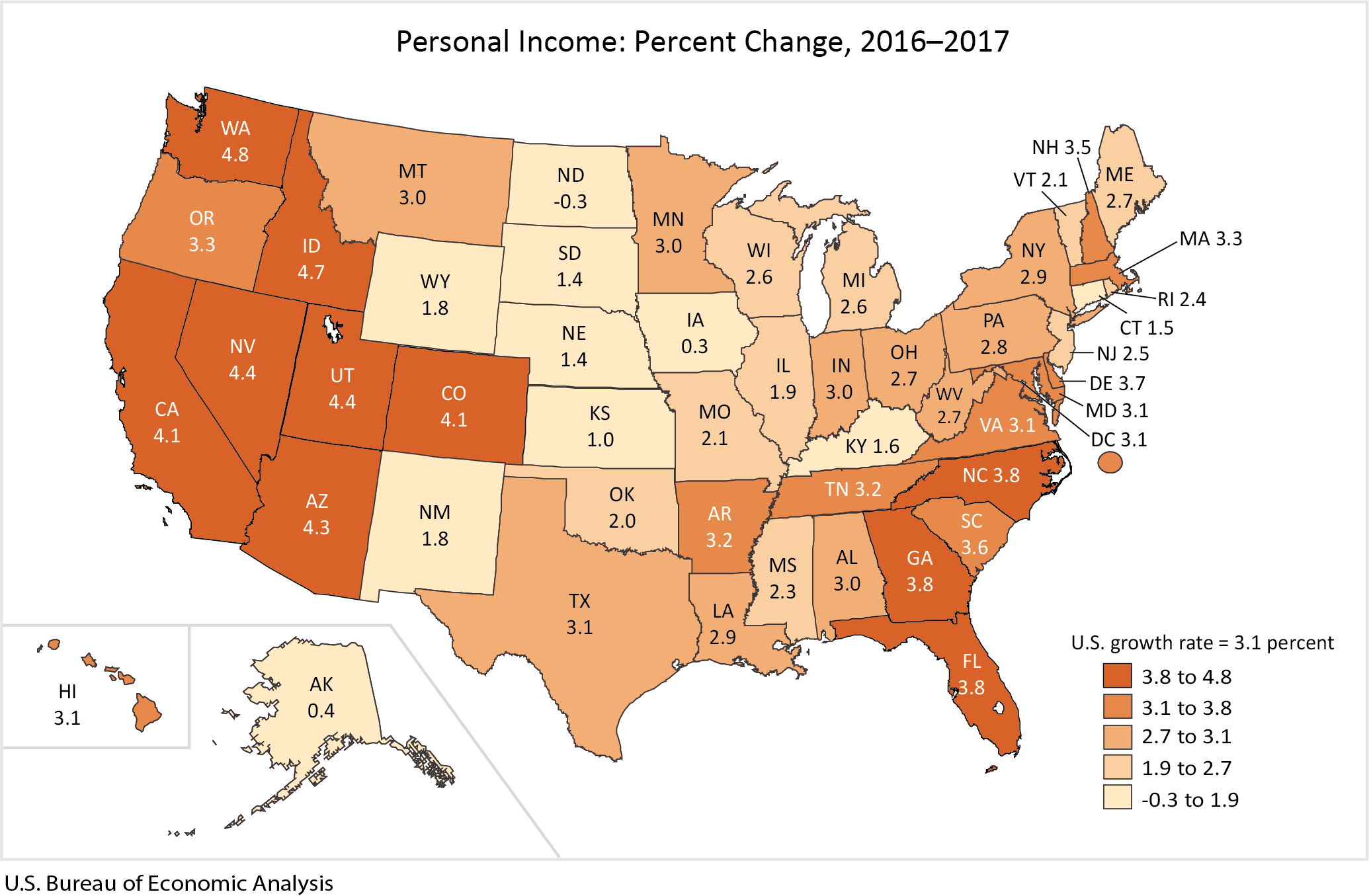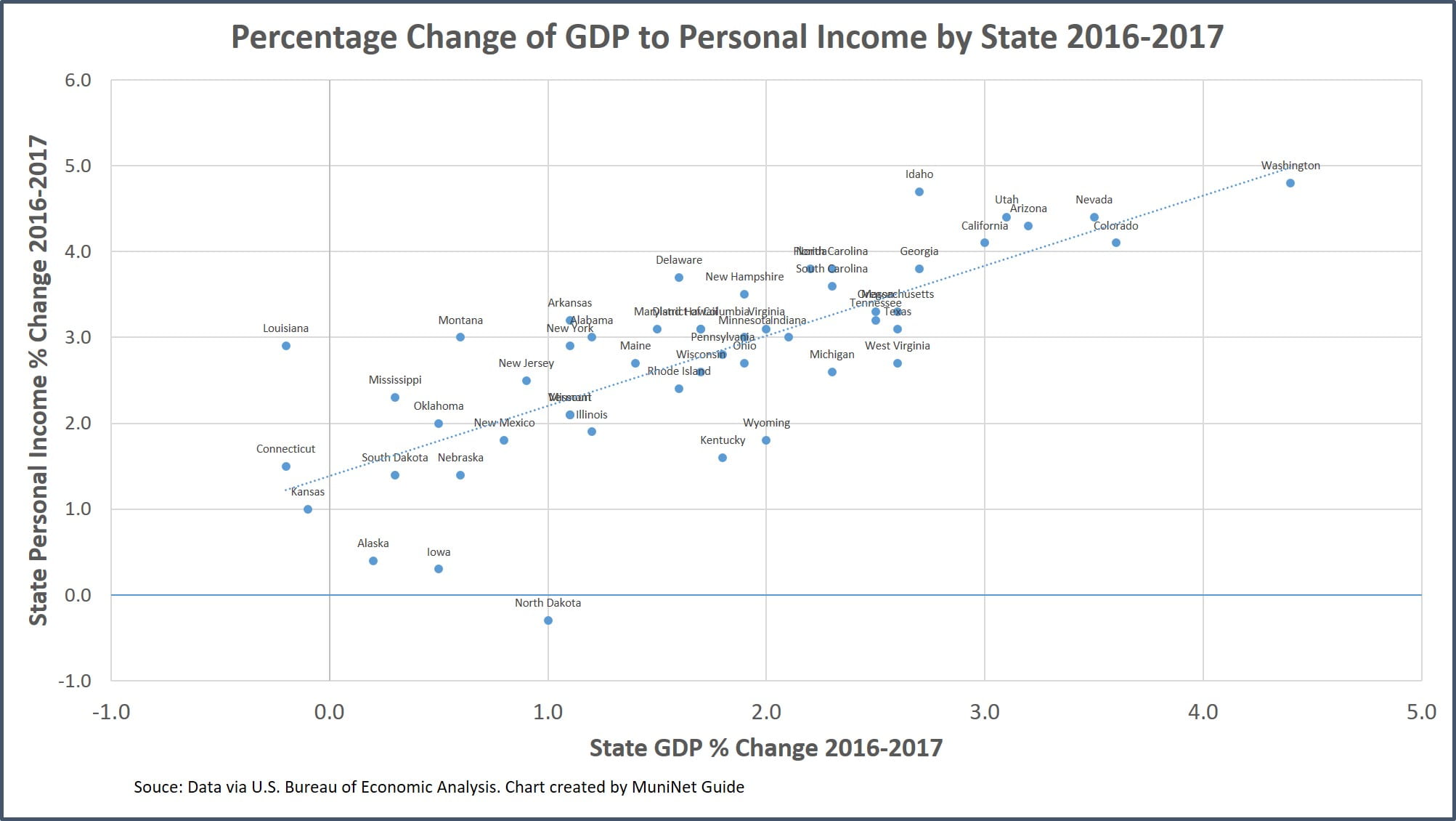State GDP Growth Figures for 2017 Lag Income Growth
Last year was one of positive momentum for U.S. state economies and incomes, keeping along the upward path of national GDP and personal income figures over the recovery from the Great Recession. Prosperity is not spread evenly across the nation, with some states making strong strides in both economic activity and incomes, some lagging in both measures, and others showing strong performances in one but not the other. There are interesting relationships between the overall economy represented by GDP and personal incomes; growth for one does not necessarily translate to growth for both metrics.
Gross Domestic Product
The U.S. Bureau of Economic Analysis (BEA) has released its State Gross Domestic Product growth figures for 2017, and the news is mostly positive. The District of Columbia and 47 states all experienced positive growth. However, only six states met or surpassed a 3% GDP growth rate, and each of those states are in the far western part of the United States; Washington State led all states with 4.4% growth, followed by Colorado (3.6%), Nevada (3.5%), Arizona (3.2%), Utah (3.1%), and California (3.0%). Washington’s strong growth was driven by the retail and information sectors; the second and third largest private employers in the state represent information (Microsoft, 43k employees) and retail (Amazon, 25k employees).
The map above represents the higher economic growth trends in the west and southwest, as Idaho, Texas, and Oregon all additionally experienced growth of 2.5% or higher. Georgia, West Virginia, Massachusetts, and Tennessee also experienced growth above this benchmark, and generally, the southern eastern-seaboard states grew faster than their northern counterparts and much of the interior. Only three states had shrinking economies last year, each barely so; Connecticut (-0.2%), Louisiana (-0.2%), and Kansas (-0.1%).
Personal Income
MuniNet reported on the BEA’s state personal income changes earlier this spring, but it is worth revisiting for a comparison to overall economic growth. State personal incomes grew considerably faster than the overall economy as represented by GDP in 2017; the median state growth rate for GDP was 1.5%, while the median rate for personal income was 3.0%. Personal income growth shows the same geographic pattern as GDP growth, with far western states turning in the best performances, followed by the region along the southern eastern-seaboard. Washington State again led all states with 4.8% growth, and only North Dakota (-0.3%) experienced personal income decline.
Personal income growth shows the same geographic pattern as GDP growth, with far western states turning in the best performances, followed by the region along the southern eastern-seaboard. Washington State again led all states with 4.8% growth, and only North Dakota (-0.3%) experienced personal income decline.
Income Outpaces Economic Growth
The chart below plots the growth pattern of personal income for each state relative to GDP growth. A positive correlation exists between the two, which is what we would expect, as a component of GDP includes personal consumption spending, which generally increases with income. Two more interesting aspects stand out: first, there is a general pattern of income growth for a given state being higher than that state’s GDP growth, although there are exceptions; second, the correlation between personal income growth and GDP growth becomes stronger the higher the rate of GDP growth. The 13 states that had GDP growth of 1.0% or less have a seemingly random pattern of personal income growth, while the six states that had GDP growth of 3.0% or higher fit into nearly a linear pattern.

What is clear is that the residents of states can achieve gains in personal income, or the income received from laborers in production, from owning a home or business, from the ownership of financial assets, and from government and business in the form of transfers, despite lagging performance in the overall economy, but a strong economy certainly helps.
Readers can find data on unemployment and labor force trends in all 50 states as well as all U.S. metropolitan areas in MuniNet Guide’s Employment Database, as well as employment growth by industry and occupational wage scale data, on our Job Market page. Job seekers can use this information to better search our Job Listings section.
by Jeffrey L Garceau, Research Coordinator for MuniNet Guide
